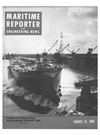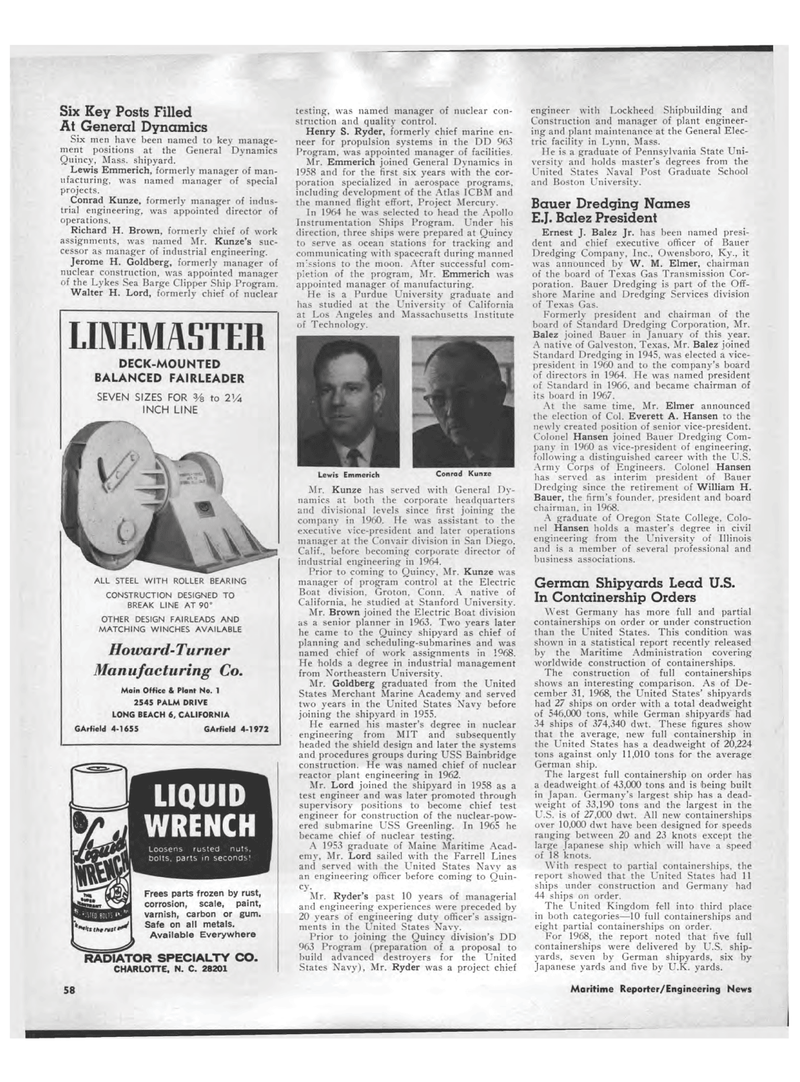
Page 56: of Maritime Reporter Magazine (August 15, 1969)
Read this page in Pdf, Flash or Html5 edition of August 15, 1969 Maritime Reporter Magazine
Six Key Posts Filled At General Dynamics Six men have been named to key manage-ment positions at the General Dynamics Quincy, Mass. shipyard. Lewis Emmerich, formerly manager of man-ufacturing, was named manager of special projects. Conrad Kunze, formerly manager of indus-trial engineering, was appointed director of operations. Richard H. Brown, formerly chief of work assignments, was named Mr. Kunze's suc-cessor as manager of industrial engineering. Jerome H. Goldberg, formerly manager of nuclear construction, was appointed manager of the Lykes Sea Barge Clipper Ship Program. Walter H. Lord, formerly chief of nuclear LMEMASTER DECK-MOUNTED BALANCED FAIRLEADER SEVEN SIZES FOR 3/s to 214 INCH LINE ALL STEEL WITH ROLLER BEARING CONSTRUCTION DESIGNED TO BREAK LINE AT 90° OTHER DESIGN FAIRLEADS AND MATCHING WINCHES AVAILABLE Howard-Turner Manufacturing Co. Main Office & Plant No. 1 2545 PALM DRIVE LONG BEACH 6, CALIFORNIA GArfield 4-1655 GArfield 4-1972 'LIQUID 1 WRENCH Loosens rusted nuts, bolts, parts in seconds! u Frees parts frozen by rust, corrosion, scale, paint, varnish, carbon or gum. sfe o" f" ?etals-Available Everywhere RADIATOR SPECIALTY CO. CHARLOTTE, N. C. 28201 testing, was named manager of nuclear con-struction and quality control. Henry S. Ryder, formerly chief marine en-neer for propulsion systems in the DD 963 Program, was appointed manager of facilities. Mr. Emmerich joined General Dynamics in 1958 and for the first six years with the cor-poration specialized in aerospace programs, including development of the Atlas ICBM and the manned flight effort, Project Mercury. In 1964 he was selected to head the Apollo Instrumentation Ships Program. Under his direction, three ships were prepared at Quincy to serve as ocean stations for tracking and communicating with spacecraft during manned missions to the moon. After successful com-pletion of the program, Mr. Emmerich was appointed manager of manufacturing. He is a Purdue University graduate and has studied at the University of California at Los Angeles and Massachusetts Institute of Technology. Lewis Emmerich Conrad Kunze Mr. Kunze has served with General Dy-namics at both the corporate headquarters and divisional levels since first joining the company in 1960. He was assistant to the executive vice-president and later operations manager at the Convair division in San Diego, Calif., before becoming corporate director of industrial engineering in 1964. Prior to coming to Quincy, Mr. Kunze was manager of program control at the Electric Boat division, Groton, Conn. A native of California, he studied at Stanford University. Mr. Brown joined the Electric Boat division as a senior planner in 1963. Two years later he came to the Quincy shipyard as chief of planning and scheduling-submarines and was named chief of work assignments in 1968. He holds a degree in industrial management from Northeastern University. Mr. Goldberg graduated from the United States Merchant Marine Academy and served two years in the United States Navy before joining the shipyard in 1955. He earned his master's degree in nuclear engineering from MIT and subsequently headed the shield design and later the systems and procedures groups during USS Bain-bridge construction. He was named chief of nuclear reactor plant engineering in 1962. Mr. Lord joined the shipyard in 1958 as a test engineer and was later promoted through supervisory positions to become chief test engineer for construction of the nuclear-pow-ered submarine USS Greenling. In 1965 he became chief of nuclear testing. A 1953 graduate of Maine Maritime Acad-emy, Mr. Lord sailed with the Farrell Lines and served with the United States Navy as an engineering officer before coming to Quin-cy. Mr. Ryder's past 10 years of managerial and engineering experiences were preceded by 20 years of engineering duty officer's assign-ments in the United States Navy. Prior to joining the Quincy division's DD 963 Program (preparation of a proposal to build advanced destroyers for the United States Navy), Mr. Ryder was a project chief engineer with Lockheed Shipbuilding and Construction and manager of plant engineer-ing and plant maintenance at the General Elec-tric facility in Lynn, Mass. He is a graduate of Pennsylvania State Uni-versity and holds master's degrees from the United States Naval Post Graduate School and Boston University. Bauer Dredging Names E.J. Balez President Ernest J. Balez Jr. has been named presi-dent and chief executive officer of Bauer Dredging Company, Inc., Owensboro, Ky., it was announced by W. M. Elmer, chairman of the board of Texas Gas Transmission Cor-poration. Bauer Dredging is part of the Off-shore Marine and Dredging Services division of Texas Gas. Formerly president and chairman of the board of Standard Dredging Corporation, Mr. Balez joined Bauer in January of this year. A native of Galveston, Texas, Mr. Balez joined Standard Dredging in 1945, was elected a vice-president in 1960 and to the company's board of directors in 1964. He was named president of Standard in 1966, and became chairman of its board in 1967. At the same time. Mr. Elmer announced the election of Col. Everett A. Hansen to the newly created position of senior vice-president. Colonel Hansen joined Bauer Dredging Com-pany in 1960 as vice-president of engineering, following a distinguished career with the U.S. Army Corps of Engineers. Colonel Hansen has served as interim president of Bauer Dredging since the retirement of ^A^illiam H. Bauer, the firm's founder, president and board chairman, in 1968. A graduate of Oregon State College, Colo-nel Hansen holds a master's degree in civil engineering from the University of Illinois and is a member of several professional and business associations. German Shipyards Lead U.S. In Containership Orders West Germany has more full and partial containerships on order or under construction than the United States. This condition was shown in a statistical report recently released by the Maritime Administration covering worldwide construction of containerships. The construction of full containerships shows an interesting comparison. As of De-cember 31, 1968, the United States' shipyards had 27 ships on order with a total deadweight of 546,000 tons, while German shipyards had 34 ships of 374,340 dwt. These figures show that the average, new full containership in the United States has a deadweight of 20,224 tons against only 11,010 tons for the average German ship. The largest full containership on order has a deadweight of 43,000 tons and is being built in Japan. Germany's largest ship has a dead-weight of 33,190 tons and the largest in the U.S. is of 27,000 dwt. All new containerships over 10,000 dwt have been designed for speeds ranging between 20 and 23 knots except the large Japanese ship which will have a speed of 18 knots. With respect to partial containerships, the report showed that the United States had 11 ships under construction and Germany had 44 ships on order. The United Kingdom fell into third place in both categories?10 full containerships and eight partial containerships on order. For 1968, the report noted that five full containerships were delivered by U.S. ship-yards, seven by German shipyards, six by Japanese yards and five by U.K. yards. 58 Maritime Reporter/Engineering News

 55
55

 57
57
